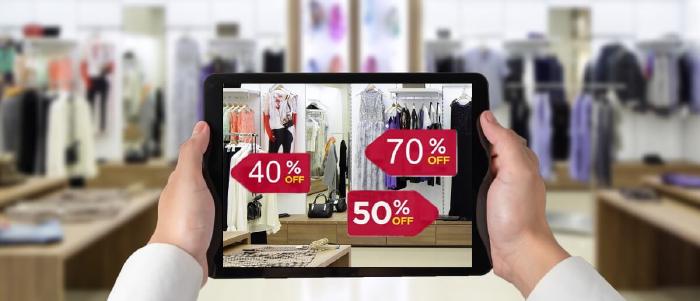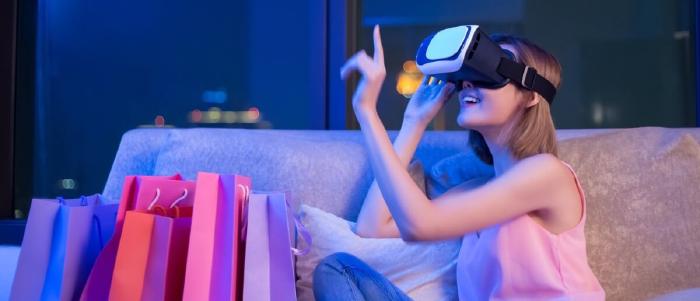
Sep 23 2022
7 min read

You are on a one-hour deadline to buy a new pair of shoes. Upon entering the showroom, your intention to exit quickly is thwarted by vibrant, immersive digital signs that catch your attention, turning your quick trip into an engaging shopping experience.
In contemporary consumerism, shoppers are on the hunt for more than just products - an enriching experience! A survey reveals a striking insight! Over 67% of customers often base their purchasing decisions on the compelling visuals showcased through a retail store’s digital signage.
But how does one curate such an impactful customer journey? The secret sauce involves devising a meticulously planned experiential retail (or “(retailtainment)[https://www.pickcel.com/blog/retailtainment-definition-and-examples/]” )strategy. Globally, prominent brick-and-mortar stores are adopting retail digital signage solutions to nail this objective. Let us see how it works.
In-store digital signage refers to using digital displays within a retail environment to communicate messages, advertise products, and enhance customer experiences. It serves multifaceted purposes as a vibrant medium to communicate important messages such as the store’s operating hours, promotions, offers, and advertisements. These retail signs drive sales by influencing purchasing decisions, creating a personal branding experience that resonates with the shopper’s needs and preferences.
Navigating the competitive retail terrain demands a distinctive approach that separates your outlet. A closer look at your competitors’ strategies reveal a common thread focusing on three pivotal elements - product, service, and experience. Are you on a quest to elevate your own customer experience? The following examples will guide you right.
Jo Malone harnessed it’s in-store digital signage displays to create an eye-catching and engaging retail experience for customers by encouraging them to combine various fragrances in the store. Instead of overloading their target audience with product information, they used visual language to explain each scent. Customers could simply pick a bottle of perfume off the shelf to see an elegant representation of the fragrance. They could also identify complementary aromas and combine them to create a customized vial.
With its captivating digital signage, Jo Malone was able to -
Achieve 25% higher product lift and 16X ROI.
Capture customer attention with the stunning visual representation of different scents.
Educate prospective buyers on essential oils and aroma compounds used in each perfume.
Advertise the latest products to drive customers with high purchase intent.
Adidas’s German headquarters presented this concept at their stores in AG, Herzogenaurach. The Adidas Virtual Footwear Wall— that blended digital signage technology and user experience— launched as a pre-booking campaign for the F50 miCoach football boot. It left customers thrilled with its immersive retail signage, virtual product experience.
The digital wall allowed customers to explore the shoe’s 360-degree model with an interactive touch display and an immersive sound experience. They could inspect shoes inside out, rotate, zoom in, and analyze every tiny detail. This campaign garnered excellent traction for Adidas’ latest product and ensured a successful launch that hit all sales targets:
Brand exclusivity by the never-seen-before digital signet technology and presentation.
End-users could virtually feel the shoes in their shape, size, color, and model variations.
Try For FreeDecathlon is leveraging interactive kiosk to chip in on the rising popularity of self-service in retail shopping. The customers can browse products, add them to cart, and make payments. The store staff can package the products and deliver them to the shoppers while they browse around the store, test-drive the sports merch or simply run errands in between.
Another type of self-checkout PoS system allows the customers to drop their products on an RFID basket. The products are automatically added to the customer’s electronic shopping cart. They can make the payments and checkout with the products.
So, What’s the advantage?
Self-service lets the tech-savvy shoppers bypass the long queues at the billing counter.Customers get orders processed faster and reduced load.
With self-service, once the order is placed, the customer is physically free to roam around the store survey more products. A lot of times, this casual product browsing leads to a second round of purchase.
Add to your Reading List: How Pickcel's digital signage software helped in Decathlon's digital transformation
Aritaum, a renowned Korean franchise beauty store, specializes in skincare and on-trend color collections. It proudly features brands like Laneige, Innisfree, and Happy Bath, with thousands of stores scattered across Korea, China, and North America. Aritaum has solidified its position as the go-to destination for K-Beauty trends.
However, despite its strong offline presence, Aritaum recognized the need to tap into the market more effectively. The company recently introduced interactive technology to entice walk-in customers and enhance store engagement and brand recall. From touchable mirror displays to captivating AR content, Aritaum went above and beyond to elevate in-store experiences with digital signage.
Customers could indulge in in-depth skin examinations and consultations for free using IOPE Bio Lab’s state-of-the-art skin health machine. With the help of “beauty mirrors,” customers could virtually try on Laneige makeup products by using tablets linked to the brand’s mobile app. By analyzing their skin tone, the mirror gave personalized makeup recommendations, ensuring the most suitable products for each customer.
Moreover, the store featured photo booths and “digital skincare bars” that offered instant access to product information and reviews. Users could simply scan a QR code and add desired products to their wish list for future buying. This digital signage campaign played a vital role in promoting:
High in-store customer engagement due to shoppers interacting with a variety of products and receiving free expert advice.
Increased awareness of the brand’s sub-product lines and offerings.
Personalized in-store signage experiences fostering strong relationships with valued customers.
With the integration of digital signage, Aritaum successfully enhanced customer experiences fostered brand loyalty, and strengthened its market presence in the beauty industry.
When you hear the phrase - “fast food,” which brand comes to the top of your mind? McDonald’s, right? This fast-food brand is loved worldwide and was one of the early adopters of digital signage in the industry. McDonald’s menu signs – which can be found at every store – serve multiple purposes. They are not only easier to see from a distance but offer several benefits over conventional menu boards. These include:
McD staff can seamlessly update product specifications whenever prices change, or new items are added. This prevents last-minute confusion during order processing.
Besides the McD restaurants, the brand also installed interactive self-service digital signage kiosks at various spots like drive-thru zones, and malls. It allowed faster checkouts resulting in more sales.
A study conducted by Iowa State University found that people use images to decide on food options. By choosing a digital signage menu over conventional menus, McD helped its customers leverage visuals to improve decision-making.
Finding the right shade of foundation or lipstick can be an uphill battle for makeup enthusiasts. Although many brands offer free testers as samples, they aren’t available for all products.
Would you believe us if we told you digital signage could solve this problem?
As crazy as it sounds, cosmetic brand MAC used digital signage technology to create a remarkably immersive experience for its customers. The American cosmetics manufacturer set up an interactive AI-based screen, which allowed customers to get a virtual makeover before purchasing. The simulator was a success because:
It catered to the customer’s desire to try before they buy by allowing them to explore various products and shades on their face using AI-powered cameras.
Retailers could cut down costs as it eliminated the need for free product trials.
MAC was lauded as one of the first brands that used immersive technology to provide unparalleled customer service.
You can significantly enhance your in-store marketing strategies using digital signage by implementing the following approaches:
Digital signage screens are not just for showing generic content. You can personalize recommendations for your customer base by analyzing customer data and preferences.
Customers, especially Gen-z, have a strong social media presence. Creating a seamless omni-channel experience by integrating digital signage with online marketing efforts like social media feeds, online reviews, or user-generated content helps to build trust for the brand.
People like things that look good. That’s why using high-quality visuals and videos to showcase products in action, tell brand stories, or demonstrate product use is more compelling than traditional static displays.
Today, in-store customer experience is a huge driving factor in sales. You can use in-store digital signage displays to send positive brand messages across your retail locations. Some of the world’s biggest retail brands are capitalizing on their digital signage strategies and innovations in a race to provide unique customer experiences. So, what are you waiting for? Reach out to Pickcel to get the ball rolling!

Sep 23 2022
7 min read
![What are 3D digital billboards for advertising? [5 Examples]](/blog/images/3d-advertising-billboard/banner_hu3a52995533a2f5f6af3321531a883f0d_86539_700x0_resize_q75_box.jpg)
Sep 8 2022
6 min read

Sep 6 2022
9 min read

Aug 18 2022
6 min read
Take complete control of what you show on your digital signage & how you show it.
Start Free Trial Schedule My DemoSee How Amazon Solved Retail Marketing Challenges – Boosted Sales & Conversions by Almost 27%
Unlock Exclusive Insights